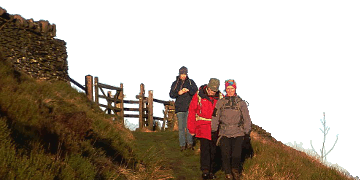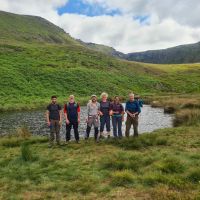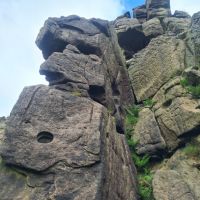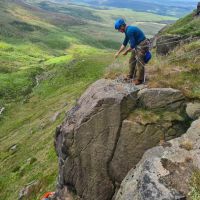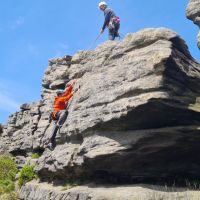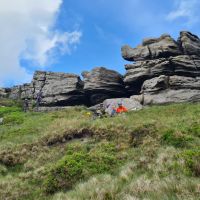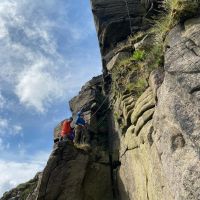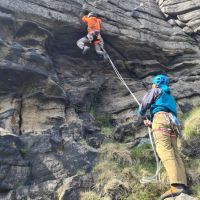Kinder downfall
Kinder Downfall and the physics of rock climbing
19th June 2021
Members present: Gareth Williams (meet leader), Cathy Gordon, Gowry Sisupalan, Andy Stratford, Jim Symon
Prospective members: Steve Torley, Jacob Torley
Climbing physics principle 1 (the big plan): all the members on the meet came together at a particular time in a remote car park and the meet came into being.
The meet was off to a great start with a team of 7 assembled and raring to go, but there was something to sort out first: how much gear to take, and who should carry what? As the discussions ensued, time appeared to slow, explained by climbing physics principle 2 (gear-time dilation): a clock that is close to a massive body of gear will record less elapsed time than a clock situated further from the said massive body.
In those long minutes (or were they hours?) my suggestion of 2 racks between 7 was not just rejected, but ridiculed, so I tucked my rope and rack into my rucksack as our third set of gear, and we started the long walk up past Kinder Reservoir to the Mermaid’s pool. From here, I suggested we all wander up to Kinder Buttress to look at The Mermaid's Ridge (VS 4b,4c), a 3-star, 2-pitch super-classic, first climbed in 1910. Everyone was interested in the route, so we applied siege tactics. Jim led P1, and brought up Andy. I scrambled to the stance and belayed Andy on P2 whilst Jim brought up the rest of the gang one-by-one on P1. P2 has a tricky and exposed start, despatched in good style by Andy. As he set up the belay and stared to take in the rope to bring up Jim, a fine conversation ensued:
Andy: which rope are you on Jim?
Jim: on the yellow rope
Jim: TAKE IN THE YELLOW ROPE
Andy: stop shouting at me
Jim: WHAT DO YOU WANT ME TO DO, ******* WHISPER?
To allay Steve and Jacob’s fears that Jim and Andy might come to blows, I explained that this banter was a consequence of climbing physics principle 3 (Symon’s 3rd law of commotion): every action has an (un)equal and opposite reaction. After a few false starts on P2, with a couple of falls held by Andy and also protected against a nasty swing by a back-rope, everyone succeeded and agreed the route is one of the best VS’s on grit. Steve and Jacob deserve a special mention for getting up their first multi-pitch route.
Steve and Jacob had to leave early, to get home for a family commitment, but the remaining team of 5 climbers (complete with 3 racks) took a short wander up the hillside to Path Side Buttress, a small outcrop just below the Pennine Way with some delightful micro-routes. Several routes up to around VDiff were soloed or led: all good fun, but having carried that 3rd rack, I couldn’t help but observe that still only 1 rack had been used so far.
Finger in the Volcano (E1 5b **) is a great little route/problem requiring a committing pull on a pebble to attain a single finger in the volcano-shaped mono and then on to the top. I didn’t fancy pulling on that pebble on-sight, so used a top rope to reassure myself the pebble was solid before soloing the route. Everyone else top-roped the route too, some finding the reach to the pebble quite long, this despite climbing physics principle 4 (the pebble theory of relativity): the distance from the good hold to the pebble is the same no matter what the frame of reference.
By now it was high time for lunch, a perfect opportunity to learn about climbing physics principle 5 (snack-holes): Jim’s snack-hole is a region of spacetime where forces are so strong that nothing—no particles or even light—can escape from it. The team continued to Upper Western Buttress, at which point I can empirically confirm that two racks were used, alas the third which I had dutifully carried all day remained in the rucksack.
Gowry and Cathy tackled South Wall (VDiff) whilst Jim, Andy and myself descended lower, aiming to climb P1 of Lower Chimney Route (S 4a,4a) into the Jolsen Finish (VS 4b). The first pitch was, let’s say, a little dirty and resembled climbing physics principle 6 (particle accelerator): a machine to propel particles to very high speeds and energies, and to contain them in well-defined beams. Jim did a fine job of battling through the loose rock, soil and vegetation to emerge spitting out grit at the belay.
The Jolsen Finish was largely clean, if a little scrittly. The highlight of the route is traversing out along a break to an exposed step-up onto the arete. Well protected by medium-large cams, if only they hadn’t been used lower on the route and in the belay. I remember thinking of the 3rd rack sitting snugly in my rucksack, but it may as well have been in the car. Oh well, just step-up and enjoy the exposure.
Cathy and Gowry decided it was time to head back home, but Jim, Andy and I couldn’t resist the temptation of one more route. Leaf Shelf (VS 4c) looked to follow a roof-crack to a stiff pull from a jam to a flake and over to easy ground beyond. Andy set off on lead, initially unsure of the best way to reach the flake. Ever encouraging Jim shouts up “follow the 6-foot crack through the roof, even you can’t get lost on that”. But Jim had forgotten climbing physics principle 7 (Stratford's uncertainty principle): Andy can know where he is, or how fast he’s going, but not both at the same time. After a bit of campus training he thought better of that, reverted to keeping his feet on the rock and then motored through the roof and up the rest of the route in fine style.
It was now high time to head home, and a takeaway curry back at our house beckoned, where the very foundations of physics were shaken as even Jim found he couldn’t quite finish everything – see climbing physics principle 5 (snack-holes) above. That evening, I was left reflecting that perhaps we didn’t need that 3rd rack after all, and even found myself wondering if I’d actually brought it along or left it in the car, which brings me to climbing physics principle 8 (Schrödinger's rack): a thought experiment in which a hypothetical rack may be considered simultaneously both in your rucksack and in your car as a result of a random subatomic event that may or may not occur.
Regardless of whether you’re a fan of physics or not, thanks to everyone who came and made the meet such fun. Particular thanks to Andy and Jim for being such good sports, as usual.
Afterthought: the following Wednesday evening at Lawrencefield, Jacob asked me why Meringue (HVS 5a) gets a higher grade than Great Harry (VS 4c) when Meringue is so much easier to climb. Unfortunately the holy grail of climbing physics principle 9 (GUT – grade unified theory), to elegantly explain how grading works, remains a mystery.
Gareth Williams
